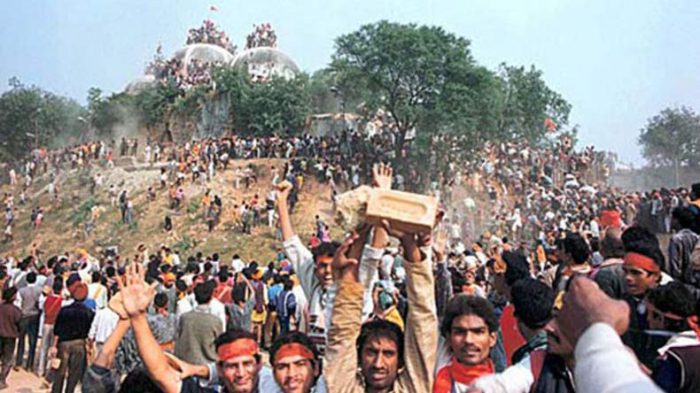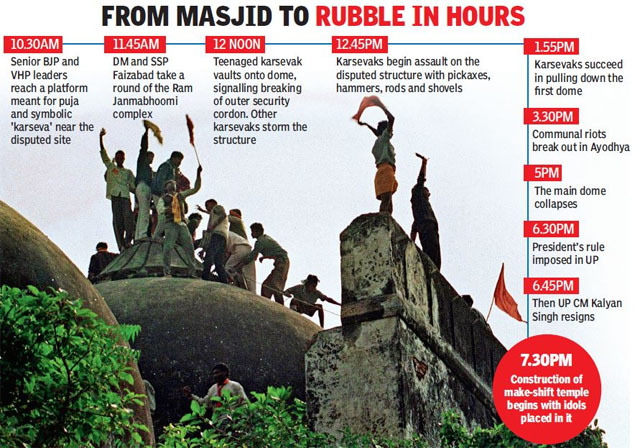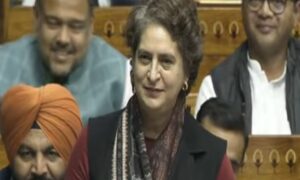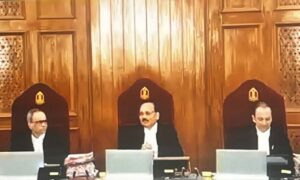
File Picture
On December 6, 1992, a large crowd of Hindu ‘karsevaks’ demolished the Babri Masjid in Ayodhya, Uttar Pradesh. The demolition occurred after a political rally at the site turned violent. Chief Minister Kalyan Singh Of the BJP had assured to the Supreme Court that no harm will be done to the dispute structure . But on the fateful day he failed to keep up his promise. His government was dismissed after the mosque was subsequently demolished.
The Vishwa Hindu Parishad (VHP) and the Bharatiya Janata Party (BJP) organised a rally at the site involving 150,000 volunteers, known as ‘kar sevaks’. The rally turned violent, and the crowd overwhelmed security forces and brought down the mosque.
Here is a chronology of the events in the years gone by :
19 April 2017: SC restores criminal conspiracy charge against leaders including L K Advani, Murli Manohar Joshi and union cabinet minister Uma Bharti in the case and clubs the trial in the matter pending against VIPs and karsevaks.
■ 6 April: SC favours time-bound completion of trial in the case and reserves order on CBI’s plea.
■ 21 March: SC suggests fresh attempts to resolve Ayodhya dispute.
■ 6 March: SC indicates it may consider reviving conspiracy charge against the BJP leaders in Babri Masjid demolition case.
■ 31 March 2015: SC issues notices to senior BJP leaders, including L.K.Advani, Murli Manohar Joshi, Uma Bharati and Kalyan Singh, on a plea not to drop charges of criminal conspiracy against them in the Babri Masjid demolition case.
■ 3 September 2013: SC advanced by about two months the date of hearing in the Babri Masjid demolition case against L.K. Advani and 19 others after the Central Bureau of Investigation (CBI) pleaded for an early hearing which was not opposed by the senior BJP leader.
■ February 2011: CBI moves Supreme Court against high court order.
■ 28 September 2010: Supreme Court rejects petition for deferment and gives the go-ahead to the Allahabad high court to deliver the judgement on the Ayodhya title issue. The high court chooses 30 September as verdict day.
■ 14 September: A writ is filed to defer the judgement but is subsequently rejected by the high court.
■ 8 September: The High Court announces verdict would be delivered on 24 September.
■ July 2010: Bench reserves its judgement and asks all parties to solve the issue amicably. But no one is keen.
■ 20 May: High court dismisses plea. Says no merit in CBI’s revision petition.
■ June 2009: The Liberhan commission investigating events leading up to the mosque’s demolition submits its report—17 years after it began its inquiry. Its contents are not made public.
■ July 2005: Suspected Islamic militants attack the disputed site, using a jeep laden with explosives to blow a hole in the wall of the complex. Security forces kill five people they say are militants, and a sixth who was not immediately identified.
■ 2 November 2004: CBI challenges before the Lucknow bench of Allahabad High Court, the dropping of proceedings against BJP leaders on technical grounds. Court issues notices.
■ September 2003: A court rules that seven Hindu leaders should stand trial for inciting the destruction of the Babri Mosque, but no charges are brought against Advani, then deputy prime minister, who was also at the site in 1992.
■ 31 August 2003: All India Muslim Personal Law Board announced it would challenge the ASI report.
Earlier, the ASI survey said there is evidence of a temple beneath the mosque, but Muslims dispute the findings. Vajpayee says at the funeral of Hindu activist Ramchandra Das Paramhans that he will fulfil the dying man’s wishes and build a temple at Ayodhya. However, he hopes the courts and negotiations will solve the issue.
■ April: Three High Court judges begin hearings on determining who owns the religious site.
■ February: BJP rules out committing itself to the construction of a temple in its election manifesto for UP assembly elections. VHP confirms deadline of 15 March to begin construction. Hundreds of volunteers converge on site.
Meanwhile, in a supposedly related incident at least 58 people are killed in an attack on a train in Godhra which was carrying Hindu activists returning from Ayodhya.
■ January: Archaeologists begin a Allahabad high court-ordered survey to find out whether a temple to Lord Ram did exist on the site. Meanwhile, PM Vajpayee sets up an Ayodhya cell in his office and appoints a senior official, Shatrughna Singh, to hold talks with Hindu and Muslim leaders.
■ 4 May 2001: Special CBI court drops proceedings against accused including Advani, Joshi, Uma Bharti, Bal Thackeray and others.
■ December 1993: Two FIRs filed in the case. One against unknown karsevaks for demolition of the mosque. The other named BJP leaders Advani, M M Joshi and others for allegedly giving ‘communal’ speeches before demolition.
■ October: CBI files composite charge sheet accusing Advani and others of conspiracy.
■ 6 December 1992: This was the turning point of the entire dispute when Babri mosque was torn down by supporters of the VHP, the Shiv Sena and the BJP, prompting nationwide communal riots between Hindus and Muslims in which more than 2,000 people die.

■ 1991: BJP comes to power in Uttar Pradesh with Kalyan Singh as chief minister.
■ 1990: VHP volunteers partially damage the mosque. Prime Minister Chandra Shekhar tries to resolve the dispute through negotiations, which fail the next year.
■ 1989: VHP lays foundations of a Ram temple on land adjacent to the disputed mosque.
■ 23 October 1989: All the four suits, pending before a Faizabad court transferred to a special bench of the HC.
■ 1989: A fresh suit is filed by former VHP vice-president Deoki Nandan Agarwala in the name of Lord Ram for declaration of the title and possession in its favour at the Lucknow bench of the Allahabad high court.
■ 1986: On a plea of Hari Shanker Dubey, a district judge directs Masjid gates to be unlocked to allow ‘darshan’. Muslims set up Babri Masjid Action Committee.
■ 18 December 1961: UP Sunni Central Board of Waqfs moves in to claim possession of the mosque and adjoining land.
■ 1959: Nirmohi Akhara enters the fray and files the third suit, seeking possession of the site, doing away with the court-appointed receiver. It claims itself to be the custodian of the spot at which Ram was supposedly born.
■ 1950: Ramchandra Paramhans files another suit, but withdraws later.
■ 24 April 1950: The State of Uttar Pradesh appealed against the injunction order.
■ 18 January 1950: First title suit is filed by Gopal Singh Visharad asking for the right to worship the idols installed at ‘Asthan Janmabhoomi´. The court restrained the removal of idols and allowed the worship to continue.
■ 1949: Idol of Lord Ram surfaces inside mosque. Muslims claim that it was kept there by the Hindus. Muslims protest, and both parties file civil suits. The government proclaims the premises a disputed area and locks the gates.
■ 1885: Mahant Raghubir Das files a suit seeking permission to build a canopy on Ram chabootra but his plea was rejected a year after by the Faizabad district court.
■ 1859: British officials erect a fence to separate the places of worships, allowing the inner court to be used by Muslims and the outer court by Hindus.
■ 1853: First recorded incidents of communal violence at the disputed site take place.
■ 1528: A mosque is built on the site by Mughal emperor Babar which Hindus allege to be the birth place of Lord Ram and where a temple earlier existed.


















